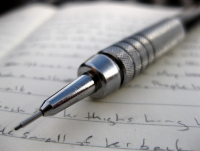








A mechanical pencil is a type of pencil in which the graphite lead is not attached to the outer casing as is in standard pencils. The lead consists of a thin stick of graphite, wax and clay. This means that the lead can be extended as it wears away removing the need for sharpening. Some mechanical pencils used recycled industrial carbon in place of graphite.
History
The mechanical pencil was invented in 1822 by Sampson Mordan and Gabriel Riddle, in England. It was more of a refillable lead holder than a mechanical pencil, as users carried uniform pieces of lead in their pockets to use when necessary. Then slowly the pencil companies modified and gave us the best light weight with extraordinary clear lead to use.
The first to patent a metal pencil with an internal mechanism for propelling the graphite (pencil lead) shaft forward during use, as an improvement on the less complex leadholders that merely clutched the pencil lead to hold it into a single position. The two received British Patent No. 4742, "Pencil holders or port crayons; pens for facilitating writing and drawing," published: 20 December 1822.
"After buying out Hawkins' patent rights, Mordan entered into a business partnership with Gabriel Riddle from 1823 to 1837. The earliest Mordan pencils are thus hallmarked SMGR. After 1837, Sampson Mordan ended the partnership with Riddle and continued to manufacture pencils as "S.MORDAN & CO". His company continued to manufacture pencils and a wide range of silver objects until World War II, when the factory was bombed" (Wikipedia article on Mechanical pencil, accessed 01-03-2013).
"Mordan often made his pencils in whimsical "figural" shapes that resembled animals, Egyptian mummies, or other objects; like his other silverware and goldware, these pencils are now highly collectible" (Wikipedia article on Sampson Mordan, accessed 01-03-2013).